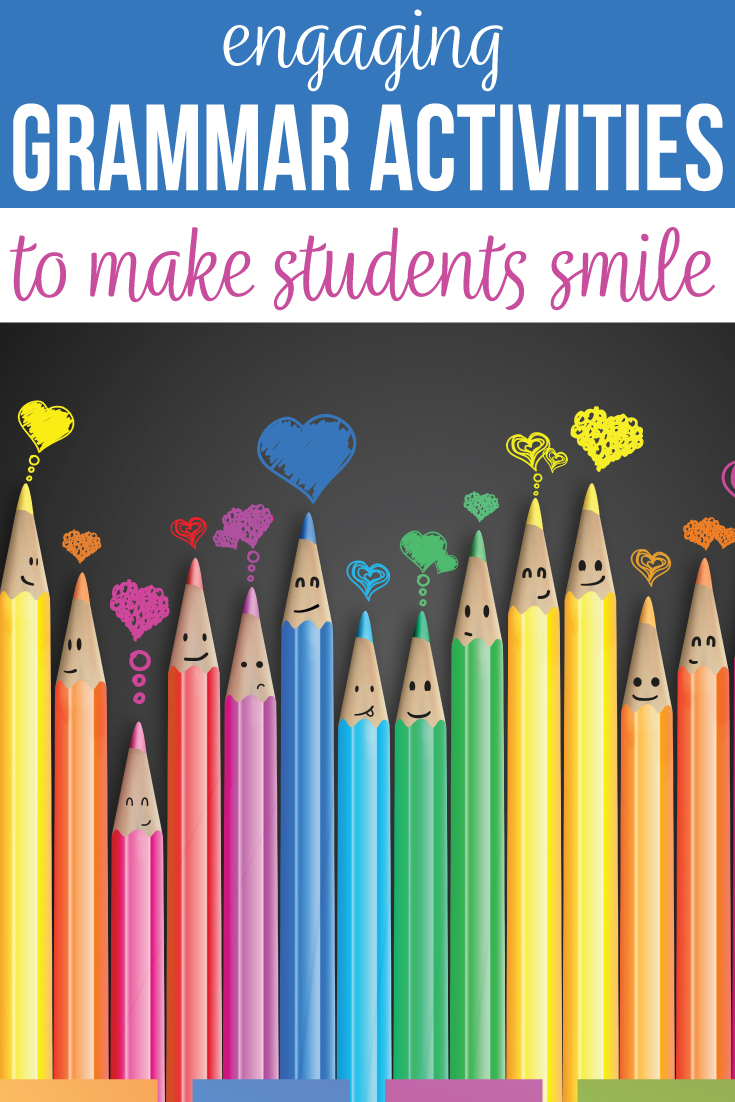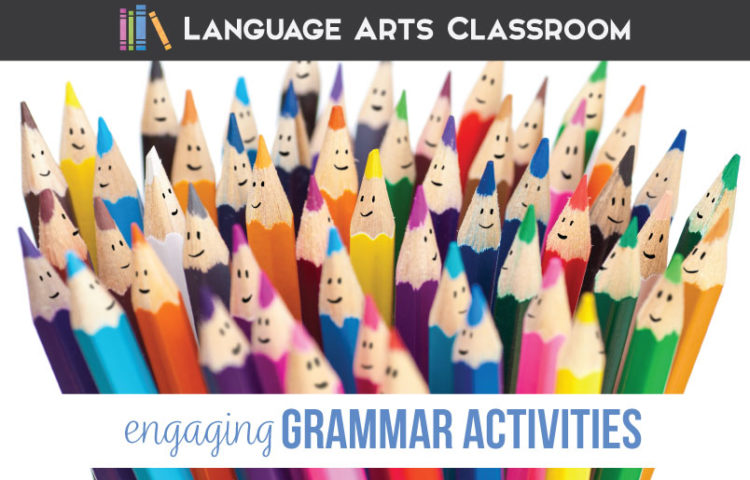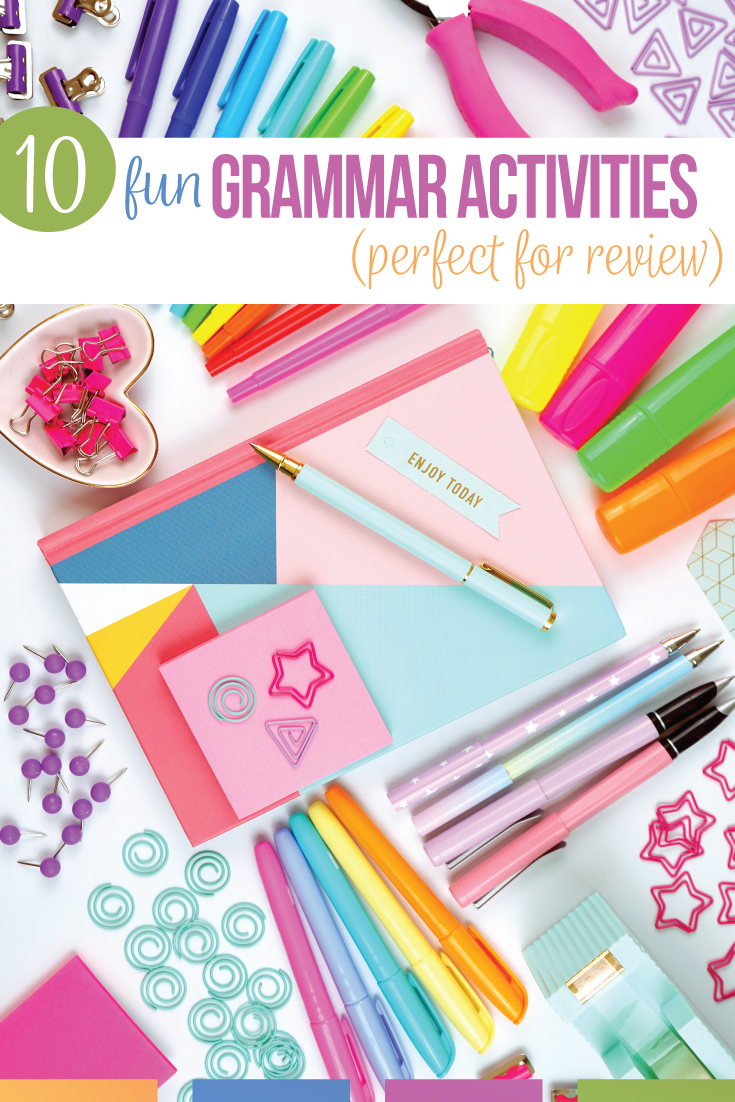Engaging grammar activities for review. . . these fun grammar activities will cement your grammar lessons.
Reflecting on my teaching experiences, I complete grammar review with classes for dozens of reasons. We clarify rules for college entrance exams. We review grammar before final exams and as we transition from one unit to the next. Oftentimes, we review during writing projects to strengthen our writing and correct common grammar errors, often referenced as teaching grammar in context. Finally, we also review grammar as we find examples in our reading and writing.
Do engaging grammar activities exist?
Yes! First, English grammar is more than “correct grammar.” Second, we teachers can apply fun activities from writing and literature to grammar. Third, from types of sentences to parts of speech, an activity or two will reinforce lessons.
Overall, a quick review can provide the very explanation a student or two needed. Fun grammar activities, such as synonym scramble and verb-adverb charades, can reinforce synonyms and build vocabulary skills while also making grammar lessons more engaging. These activities don’t require a lot of planning time and can easily be incorporated into existing worksheets for a more interactive learning experience.
Below, I detail some grammar activities that will work in multiple situations.

No matter the purpose, I’m always searching for engaging grammar activities for review. If you’ve been around this blog for a bit, you know that I search for and invent ways to make grammar engaging. Below, I’ve listed ten ways to create engaging grammar review.
You should be able to duplicate these grammar activities!
Start with basics (nouns, conjunctions, adverbs. . . )
No matter the topic, you will want to cover basics so that no student is confused. For instance, if you are reviewing active and passive voice, start with a quick video over definitions. If you cover parts of speech, provide funny examples or mentor texts to review. Finally, when students take notes, they remember the concepts.
Dive into practice and ask students to keep their notes on their desks. To really focus on the basics, keep definitions, hints, and lists at the forefront for specific review.
I will model this for classes. Sit in a desk with an activity and the notes. Model how you return to notes to identify the components in the practice.
If you need less of review and more direct instruction, you might look at Ten Alternatives to the Grammar Worksheet. Those grammar activities focus more on instruction.
Build on prior knowledge
When I review grammar concepts, I connect how students will use that information in their writing or speaking. For instance, I might ask writers to use fewer linking verbs. Classes will need to know what a linking verb is, be able to find them in their papers, and know how to add an action verb. The same processes apply with “use active voice” and “correct verb tense.” One part of grammar review is sharing that connection verbally—very deliberately.
Although some may seem like a large discussion, it normally is quick. Simply say, “On our last writing assignment, I encouraged many of you to experiment with your verbs. You found linking verbs in your papers and decided if they should stay linking verbs or become action verbs. Now we are going to look at active voice. This concept also deals with verbs.”
When I review grammar, this does not mean that my students have a worksheet. They might be writing a reflective paragraph or inventing a character with a certain directive that involves grammar. We might complete a digital activity that provides immediate feedback and then apply the grammatical concept to writing. Engaging grammar activities connected to writing allows conferencing individually.
Provide a visual
When students can grasp a visual, they can imagine the grammar concept. I create visuals in several ways. With a bit of creativity and student involvement, you will soon have your own fun grammar activities that include meaningful visuals.
An anchor chart is one such visual. What I appreciate about anchor charts is that we can add so frequently to them. Want to add new rules or reminders? Add an extension to the chart. Want to add examples? Ask students to write examples on sticky notes and attach them as exit tickets.
A visual that you create as a community works too. Often, these visuals are metaphors you create as a class. I joke with my students that they are learning about different “flavors” to add to sentences and that they are chefs. Yes, everyone rolls eyes at my expense. Yes, they reference “vanilla” and “spicy” grammar concepts. When the teacher takes risks in talking about grammar, students have a unique way of owning that uniqueness.
Finally, add sticky notes or examples to premade grammar posters.
Encourage discussions
When students own their learning, they are more engaged and remember more than sitting and writing. Encourage discussions by asking classes to turn and share an idea with a partner. Listen to their discussions and provide feedback. You may also pick up where you need the lesson to go for more complex grammar activities. Differentiated grammar instruction empowers diverse learners. Flexible grouping, multimodal learning, scaffolding, and peer collaboration are key strategies.
If you are using grammar sorts, organize poster boards so that individuals can add the pieces together. (Then, regroup and draw conclusions about location of words and punctuation.)
Finally, bring food packages in for students to analyze. When I review grammar with food, students collaborate as they analyze the language marketers use on food packaging.
At this point, I typically assess what individuals understand and don’t understand from their discussions, normally with a list I make myself. This list guides where I will focus my attention with stations, one of my favorite engaging grammar activities methods.
Complete station work
Grammar stations can take as much or as little time as needed. Normally if I organize stations, I do plan on working stations an entire class period. Stations work incredibly well for differentiation and scaffolding.
A future goal of mine is to have enough clipboards for students to share their answer sheets. You will need answer sheets for students as they rotate. I have also use digital answer sheets.
Any activity will work for grammar stations, including worksheets. Still, I like structured station work. (You can download my free pronoun stations.) When I’ve had small classrooms, I’ve had stations even in the hallway for more space. While students move, you can circulate and help.
Students also enjoy coloring in stations, and color by grammar works well. Grammar sorts and task cards can become station work too. Fun grammar instruction exists with a few twists on tools you probably have on hand!
Stop teaching
You know the expression: If you want to really understand something, teach it. So. . . let the students create a presentation! Ask students to teach whatever grammar concept you are reviewing. Encourage them to find images that emphasize the concepts they are studying.
Not only do sentences research and create examples, but they also must present the information to their peers. Your discussions will be interesting, and I promise that students will come up with funny sample sentences.
Finally, the good news is that you can double-check the presenters’ understanding of grammar rules or whatever grammar topic they are teaching. Collecting casual data boosts your future grammar lessons.
Build sentences
My favorite of all engaging grammar activities? Grammar manipulatives. Ask students to build their sentences. Students typically spread out when they use grammar manipulatives, and the purpose can be whatever your students need you to make it. For instance, if you are reviewing comma placement, ask students to create:
- a compound sentence with a FANBOY.
- a compound sentence with a conjunctive adverb.
- a complex sentence with an introductory dependent clause.
- a simple sentence with a series.
Grammar activities don’t need to be formal! A whiteboard, a marker, and creative students might be all you need to practice grammar skills.
Create a quiz
Let the students do it! Creating a quiz is a different activity than creating a presentation in that students are not teaching others, but they are reinforcing their knowledge. I have an entire process for students creating a worksheet, but essentially, students create a quiz for their peers along with an answer key. Engaging grammar activities can include switching around a typical one! Not only will students create the worksheet or quiz, but they will also create the answer key. This process typically involves students reviewing and reading their material a few time.
As the teacher, this process shows you what students know and where they need to focus. Plus, this process is a different way of thinking. As a final bonus, you can actually use this material in your final assessment.
Of course, you can give students a quick quiz that will access where they are in their understanding. Students might need less or more of a review than you originally thought.
Anticipate frustration with exit tickets
Like any part of a class, students can become frustrated with review. If you anticipate this frustration, you will be ready to help varying learning levels and abilities. The more you teach grammar, the more you will anticipate. A quick way to assess where you need to begin grammar review the next day is with exit tickets that focus on key concepts.
Assess the exit tickets and be prepared with strengths and weaknesses of student understanding.
As a tip, be prepared with basics if you are working on advanced practice. I ask students to bring out their previous assignments that covered our current review activity: definitions, notes, writing samples, graphic organizers, and on. I anticipate that not all students will be prepared for review. Knowing that students have previous material for helping them insures that I can anticipate frustration and quickly address it.
Bring English together
Create a memorable finale to your engaging grammar activities. For instance, if I were ending a review session on semicolons, I would bring students together. I would then ask students:
For a list of places they want to travel, such as New, York, New York, Chicago, Illinois, Los Angeles, California. Then I would create a sentence properly using their list: For vacation, I am traveling to New, York, New York; Chicago, Illinois; and Los Angeles, California.
For a simple sentence, and then another simple sentence. If they struggle to think of one, I resort to writing about my dog: Augie digs in the trash and Augie sleeps on the couch. Then I would join those two simple sentences by using a conjunctive adverb: Augie doggie digs in the trash; however, I still allow him to sleep on my couch.
Then try two brief ideas, such as ordering at a restaurant. Create two simple sentences joined with a semicolon: Kiera ordered a cheeseburger and fries; she added on a milkshake.
What are some group-based activities that can be used to teach grammar in a fun way?
Finally, some engaging grammar activities work well with group-based learning like grammar scavenger hunts, grammar relay races, grammar board games, and grammar jeopardy. These activities (mentioned above) can easily be done in a group setting.
At the end of any grammar review, I conclude and really emphasize that students can implement what they just reviewed. Middle school kids need that reminder, especially!
For engaging grammar activities that focus on review, I want students to play with their language and have fun—we often work in grammar stations. I know I have a successful grammar lesson when students treat grammar as they would literature or writing; they have honest questions, they discuss the content with their peers, and they can apply the ideas to other areas. These activities are designed to make grammar fun and interactive for middle and high school ELA students, helping to develop their writing skills in an engaging way.
Do you prefer to review with games? Melissa covers grammar games over at Reading and Writing Haven.
Are you interested in more grammar review and fun grammar activities? Join Grammar Gurus, a private Facebook group where dedicated ELA teachers cover grammar activities in classroom.













